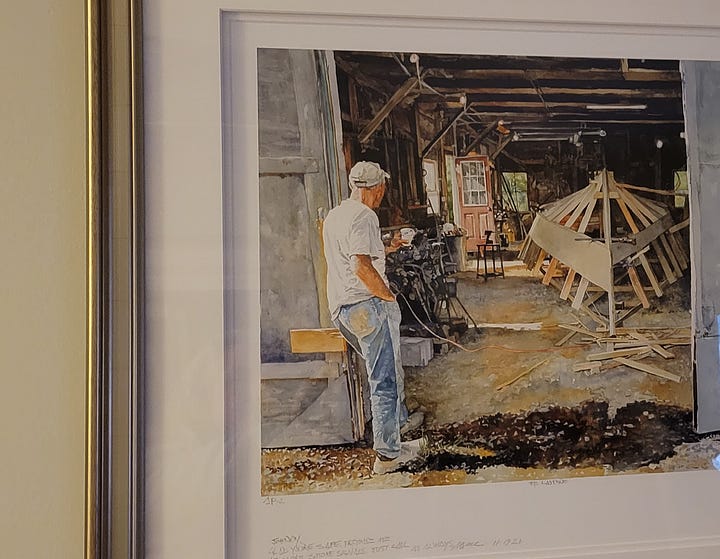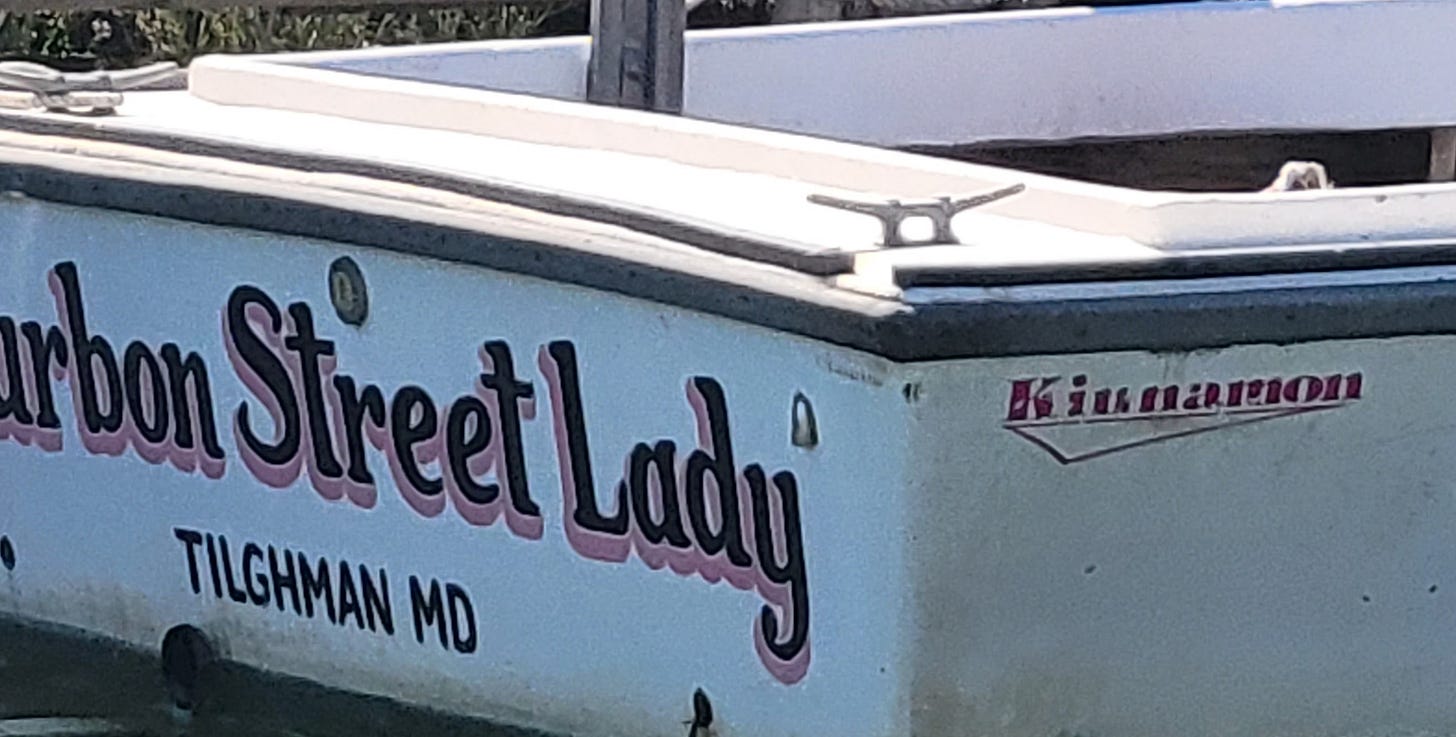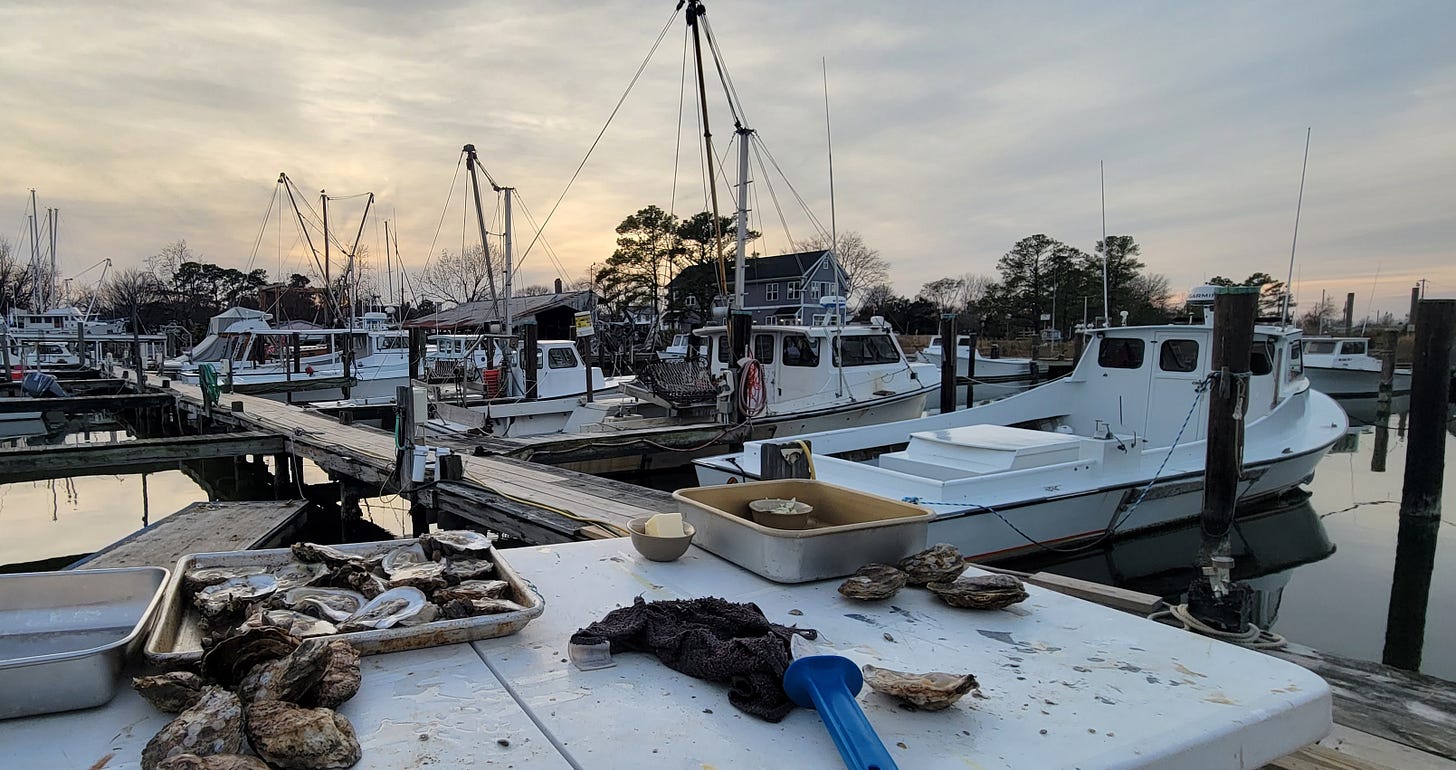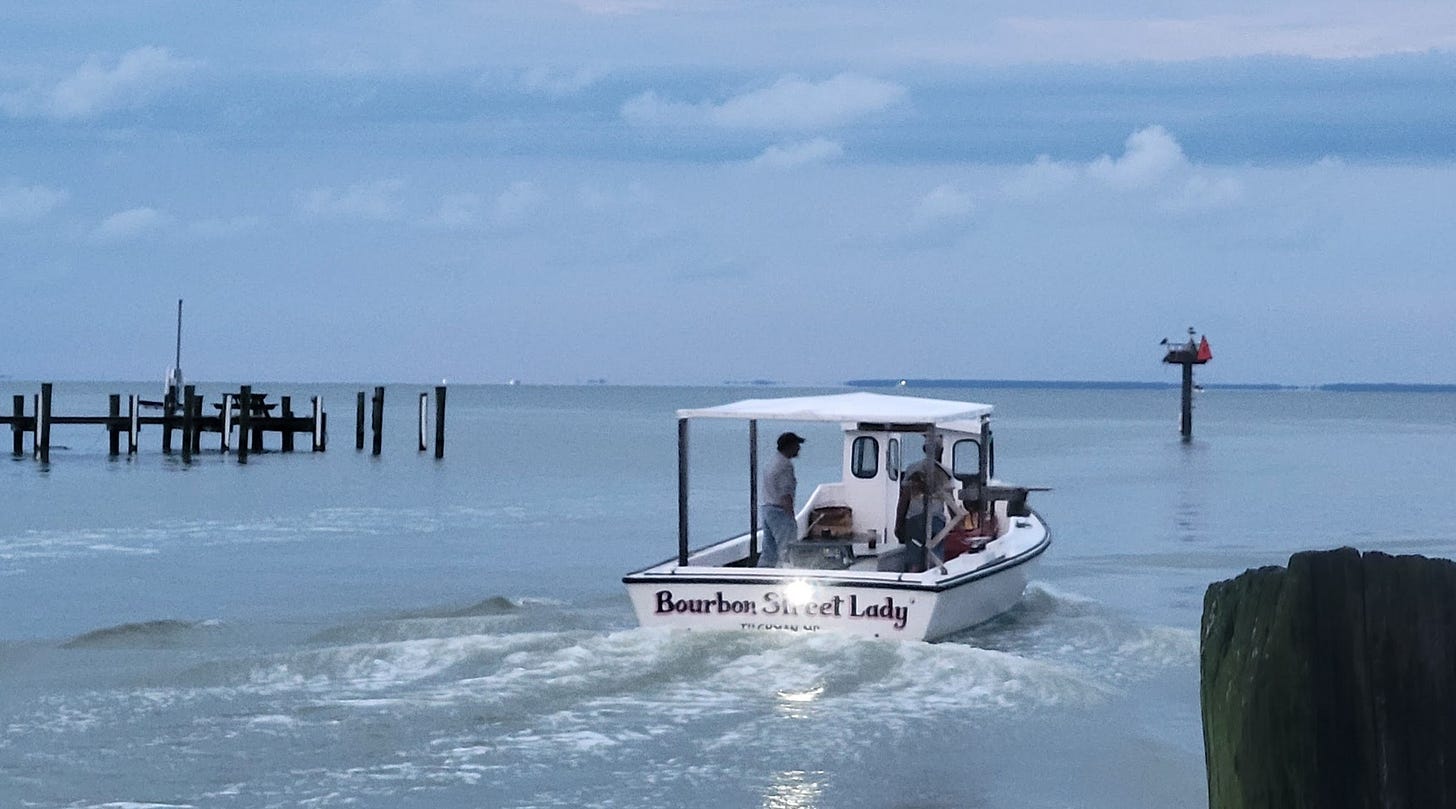A LIFE OF ROUTINES, BUT NOT A ROUTINE LIFE
Fourth in a Series, the Watermen of the Chesapeake Bay. My sailing Yacht STEADFAST is honored to be docked among these hard working people.
A Legend in the Flesh
I had seen the name. It is prominent, as a boat builder’s signature should be, and bold, but simple. Like the lines of the vessels he created. Quality, style, longevity. The man himself I had not seen, not until last summer, when the legend appeared in the second pew from the back, left side. I didn’t know his name until the congregational conversations that take place each week introduced him, told me who he was. Aha, I thought to myself, Johnny Kinnamon in the flesh.
“You build beautiful boats,” I said to him as we exited the church that stormy morning. Bright blue eyes looked at me with curiosity, a hint of amusement, and something else I could not quite identify. “I used to,” he said, nodding. “But I don’t do that anymore.” He’s 87, and that’s not exactly true.
I asked him, then, which workboat was his. “Bourbon Street Lady,” he chuckled at the memory the name aroused and took a step closer to me, reached out a huge, work-hardened hand darkened by decades of exposure to the Chesapeake, and placed it on my arm. “Let me tell you the story about that.” It was a great story, taking us back six decades to a New Orleans that no one would recognize now, to a time when he was in a Navy uniform far, far from Tilghman Island. He couldn’t afford that sort of woman back then, but now he has his very own Bourbon Street Lady, all to himself.
It was that very day, in the back of my mind, that I decided I should write his story. He is a great storyteller and I want to tell all of it as long as I could capture his essence as well as the people, actions, decisions and events that make up almost nine decades of a Waterman’s life on the Eastern Shore of Maryland. This Waterman remembers details that few people would. His character emanates quietly as those piercing eyes assess your worth. I have captured essences before, and I think I can emanate his, too, better, even, than the portraits he sits for. The portraits people pay a lot of money to possess.


“Who are you?” he queried, and the back of my mind began writing excitedly. At least I had captured his attention. I smiled at him, and hesitated for an instant; I was no local, and sometimes the locals don’t let us in. “I live on that big old wooden sailboat down at Severn Marine.” His look asked me “Why?” but he didn’t voice the question and I could see him picturing our wooden girl in his mind. “Where’s your mast?” he asked me. “Long story,” I replied, “Right now they’re both blocked up on the hard. We broke one, getting back here. Outside Hatteras.” He absorbed that silently.
“I go by there every morning around 4:30; I could blow my airhorn,” he offered, glancing at the ground and then back at me to ensure that I had a sense of humor as well as a spark of intelligence. Testing me. “Do it,” I challenged him. “I’ll reach my hand out that port and wave, you won’t miss it.” And it became a joke between us, the airhorn. It became the connection.
For decades after his military service ended and he returned to his roots, he had his routines, six days a week, crabbing in summer and oystering in winter; he was built like Popeye, they say, hand-tonging great harvests of bivalves to be sent to all corners of the world. Two years ago his house burned nearly to the ground, leaving fewer mementos than he expected to have after all those years of hard work and relationships.
While harvesting during one particular storm, he was inspired to build better boats, and he did, enhancing both the ride and design of the dead rise style workboats while updating the materials used. He built hundreds of them, the majority of which are still in use, all up and down the Eastern US. His son, JC, carries on the legacy and many days Johnny can be found by his side. He has lost his wife and a daughter, three children remain, and I imagine them trying to keep up with their quick-witted dad.
Two weeks after we met I sat one pew behind him and slightly farther from the aisle, closer to the legend, closer to the magnetism. I had settled into a routine that settles my mind (if not the questions within), at least for an hour a week. (And of course, as a writer, I still have to write about it.) Now, most weeks, I get to grab his arm (tattooed in 1957, in New Orleans) as a silent greeting when I sit down right beside him, in the same place each Sunday, and we smile. We listen in companionable silence to meaningful, high-energy words by a Pastor from whom you never know what to expect, but you can always relate. People here don’t expect Johnny and I to relate like we do, either.
That little church reminds me of where I came from, but unlike Johnny Kinnamon, I never stayed anywhere very long. I never settled into a routine where I knew all my neighbors. “If you had lived somewhere all your life,” he said to me, “You’d remember everything, too.” I doubted that special man when he said that, and wanted him to tell me all his stories even more. He has resisted me so far, but I think he might be caving. He has shared stories about his orphaned mother and given insight into his strong character. He intrigues me, this man. There are no more of them, anywhere.
That day I toured the Tilghman Waterman’s Museum with him and learned about creatively and dangerously dredging oysters on the frozen bays of Maryland’s Eastern Shore; back then they harvested more than a hundred bushels a day. I learned about his ingenuity and drive and inventions and more about the old days. I got to hear his laughter, I love his laughter. His passion for the life he was born into is enviable indeed.
These new people, “They’re mostly assholes,” he had told me frankly that first day, about the extensive number of wealthy people moving onto his island and into this region. “They don’t even talk to you.” “I’m not one of them,” I had replied earnestly, willing him to believe me. Because I’m not. And he knew that. I’m not afraid to tell you that there is a light within me that most people don’t have, and that most people don’t see. But some do. He sees it, and I’m not bragging.
I cannot express the relief and the honor I felt when he walked down the dock to see me and STEADFAST last summer. Months later he came over to watch the Holiday Parade of boats and I fed him oysters, carefully and proudly shucked by my own hands and broiled with fresh garlic, parmesan, butter and my spice blend, trying to show off some skills of my own next to these people who have made a hard living SPARRING WITH MOTHER NATURE for their entire lives.
When he left he said, “I expected a steak. You invite me over here and feed me oysters? We used to live on oysters because that was all we had.” He stunned me into silence, not a rare occurrence. He paused, softening the blow a little, “They are pretty good that way, though.” I kissed him on the cheek, and will not forget the lesson. Gourmet means different things to different people.
Rather than eat, rather than anything, Johnny would rather talk to the man of the boat, about boats. Johnny Kinnamon in the flesh. I almost have permission to write his story. Almost. And someday I’ll serve him steak.
I hope you are enjoying and learning from my Watermen series. I am living among them and feel that their dedication, knowledge and lifestyle are more than worth writing about. If you liked this story, please do click the little ‘heart’ icon at the bottom or top of this piece. It helps send this story to other parts of the world where people have no idea how much respect Waterman deserve.








- If you had lived somewhere all your life,” he said to me, “You’d remember everything, too.” -
You always include the layered quotes … they speak volumes.
Let there be steak! Fascinating start to a budding relationship. The grab of the arm, you in church reflecting, you’re inner light ( I see it too, always have) and so well written. Look forward to the day you share his story, it will be worth the wait. Thanks, J.